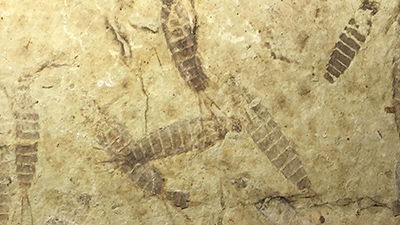Classifying the Blue Whale by Jaw Type
Another big mouth beast becomes an honorary member of the baleen club.
News Source
- Livescience: “Blue Whale’s Elastic Jaw Evolved from Stiff Maw”
“The earliest baleen whales lacked one of the hallmarks of all living (and most fossil) baleen whales: a loose lower jaw joint,” explains Erich Fitzgerald, of Australia’s Museum Victoria. “Without that loose lower jaw joint, living baleen whales could simply not feed the way they do.” Fitzgerald is describing the newly discovered fossil skull of an extinct whale, Janjucetus hunderi.
Whales can be subdivided into toothed whales and filter-feeding baleen whales. Evolutionists maintain that whales evolved from land animals, but they have been unable to decide how the big baleen-containing jaw evolved from a toothed ancestor. Fitzgerald states that now he has been “able to discover the sequence of jaw evolution from the earliest whales to the modern giants of the sea.”1
Like one other extinct whale, the Mammalodon, Janjucetus has a wide upper jaw giving it a large “palate surface area and oral cavity volume.”
Like one other extinct whale, the Mammalodon, Janjucetus has a wide upper jaw giving it a large “palate surface area and oral cavity volume.”2 Mysticetes—baleen whales—all have a big upper mouth. The large capacity of their mouths allows them to strain huge volumes of water for plankton. But the big upper mouth isn’t enough. Lacking teeth, all living baleen whales have baleen—keratin combs to filter their food from the water—but they also have a lower jaw which is unfused in the front. This elastic connection of the jawbones at the chin allows the bones to rotate outward for a really huge gulp of plankton-containing water. Evolutionists believe the loose lower jaw was the “key innovation [which] supported the evolution of titanic body sizes and the extraordinary success of mysticetes,” enabling them to consume huge quantities of food.3 (Toothed whales tend to be much smaller, like the dolphin-sized Janjucetus.)
Janjucetus and Mammalodon do not have the loose lower jaw characteristic of baleen whales. In fact, they do not even have baleen. Instead they each have a full set of teeth. Yet because they have large palates, they are now classified as baleen whales.
“The first step towards the huge mouths of baleen whales may have been increasing the width of the upper jaw [to] suck fish and squid into the mouth one-at-a-time,”4 according to Fitzgerald. “Janjucetus and the earliest mysticetes did not have the loose lower jaws that allows [sic] their living cousins to increase their mouth size and engulf huge volumes of seawater when filter-feeding on plankton such as krill and small fish. Janjucetus is a baleen whale, but not as we know them.”
Classification systems exist to organize knowledge by grouping similar organisms. The key hallmarks of the “mysticete” category—baleen and a loose lower jaw—are missing from Janjucetus and Mammalodon. Yet they are now considered ancestral members of the mysticete category simply because they have a wide palate. These fossils are not transitional forms or missing links. They simply are the skulls of toothed whales with big mouths. The ability to line up a series of fossils in a way to allow a just-so-story to be spun about them is not scientific evidence that the story is true.
There have been a series of candidates for the whale’s terrestrial ancestor. They get debunked regularly when morphological or genetic data once again reveals discrepancies. In this case, however, the researchers are not talking about the land-to-sea evolutionary sequence but rather the development of two completely different jaw types. All of the animals in this scenario are whales.
We can ask whether baleen and toothed whales were of the same created kind which diversified or whether they were different created kinds from the beginning. The vast differences between the toothed and baleen morphology at least make the “different kinds from the beginning” scenario a reasonable possibility. Nevertheless, Fitzgerald’s reference to his “toothed mysticete”5 is an oxymoron.
Further Reading
For More Information: Get Answers
Remember, if you see a news story that might merit some attention, let us know about it! (Note: if the story originates from the Associated Press, FOX News, MSNBC, the New York Times, or another major national media outlet, we will most likely have already heard about it.) And thanks to all of our readers who have submitted great news tips to us. If you didn’t catch all the latest News to Know, why not take a look to see what you’ve missed?
(Please note that links will take you directly to the source. Answers in Genesis is not responsible for content on the websites to which we refer. For more information, please see our Privacy Policy.)
Footnotes
- Victoria Gill, “Fossil Shows Huge Mouth Evolution” BBC, August 17, 2011, http://www.bbc.co.uk/nature/14551193.
- Erich M. G. Fitzgerald, “Archaeocete-like Jaws in a Baleen Whale,” Biology Letters, August 17, 2011, DOI: 10.1098/rsbl.2011.0690.
- Ibid.
- Gill, “Fossil Shows Huge Mouth Evolution.”
- Fitzgerald, Archaeocete-like Jaws in a Baleen Whale.”
Recommended Resources

Answers in Genesis is an apologetics ministry, dedicated to helping Christians defend their faith and proclaim the good news of Jesus Christ.
- Customer Service 800.778.3390
- Available Monday–Friday | 9 AM–5 PM ET
- © 2026 Answers in Genesis







